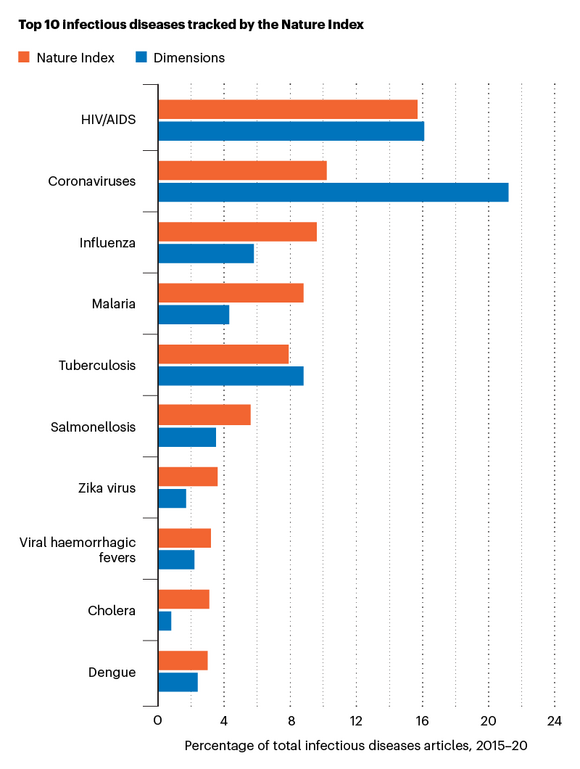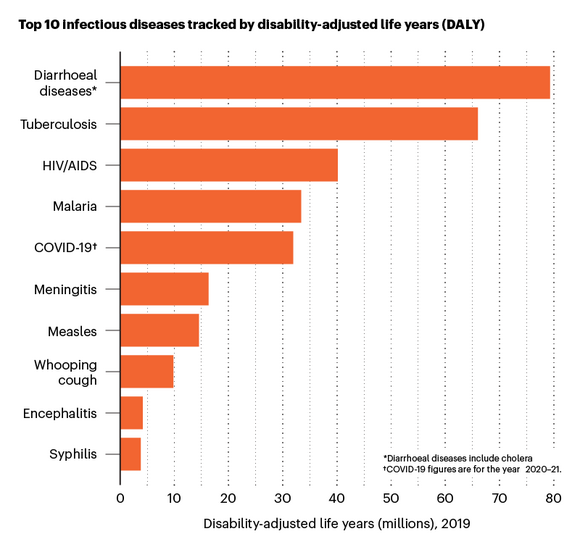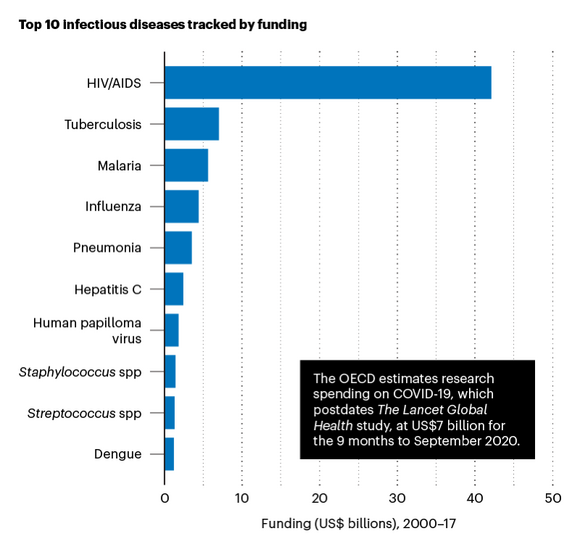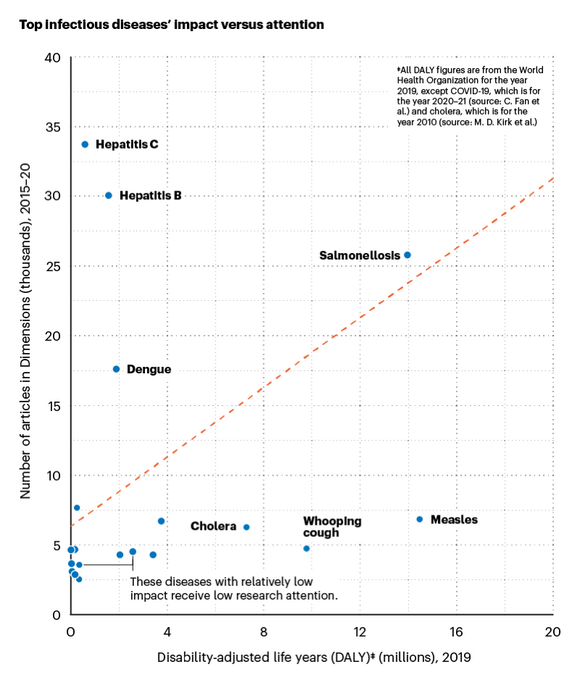
By the numbers: counting the costs of infectious illness
The impact of some of the world’s deadliest diseases, and the research effort that goes into them.
2 November 2021
Data analysis by Bo Wu. Infographic by Bec Crew & Tanner Maxwell

Which diseases have the highest output in the research literature?
The top diseases by output in the Nature Index, which tracks articles in 82 selected natural-sciences journals, are shown in orange. Articles related to HIV account for 15.7% of the total infectious-diseases-related articles for 2015–20, the highest of any infectious disease.
Output in the Dimensions database from Digital Science is shown in blue. Coronavirus dominates, accounting for 21.2% of infectious-diseases articles. The vast majority of these articles are related to COVID-19, which accounts for 19.7% of total infectious-disease-related articles in Dimensions for 2015–20.
Top infectious diseases in Dimensions that do not appear in the Nature Index top 10 are human papillomavirus (ranked fourth), hepatitis C (ranked sixth) and hepatitis B (ranked 8th).
 Source: Nature Index/Dimensions. Data analysis by Bo Wu; infographic by Bec Crew and Tanner Maxwell
Source: Nature Index/Dimensions. Data analysis by Bo Wu; infographic by Bec Crew and Tanner Maxwell
Which diseases exact the greatest toll?
One disability-adjusted life years (DALY) represents the loss of the equivalent of one year of full health. COVID-19 has quickly assumed a place among the world’s deadliest diseases.
 Sources: WHO/C.-Y. Fan et al. J. Formos. Med. Assoc. 120, S106–S117 (2021). Data analysis by Bo Wu; infographic by Bec Crew and Tanner Maxwell
Sources: WHO/C.-Y. Fan et al. J. Formos. Med. Assoc. 120, S106–S117 (2021). Data analysis by Bo Wu; infographic by Bec Crew and Tanner Maxwell
Which diseases get the most research funding?
In 2000–17, HIV/AIDS received six times more funding than tuberculosis, according to a 2020 study in The Lancet Global Health. The study examined grants made for infectious-disease research from public and philanthropic funders in G20 countries.
 Source: M. G. Head et al. Lancet Glob. Health 8, e1295-e1304 (2020). Data analysis by Bo Wu; infographic by Bec Crew and Tanner Maxwell
Source: M. G. Head et al. Lancet Glob. Health 8, e1295-e1304 (2020). Data analysis by Bo Wu; infographic by Bec Crew and Tanner Maxwell
How does disease impact compare with research output?
The diseases with the greatest global health impact aren’t necessarily the most-researched. Those above the trend line receive more research attention relative to their health impact compared with other diseases in this analysis, whereas those below it receive less.
The five most-studied diseases based on articles in Dimensions 2015–20 (coronavirus, HIV/AIDS, tuberculosis, human papillomavirus and influenza) are beyond the scale of this graph.
 Sources: Nature Index/Dimensions/WHO/C.-Y. Fan et al. J. Formos. Med. Assoc. 120, S106–S117 (2021)/M. D. Kirk et al. PLoS Med. 12, e1001921 (2015). Data analysis by Bo Wu; infographic by Bec Crew and Tanner Maxwell
Sources: Nature Index/Dimensions/WHO/C.-Y. Fan et al. J. Formos. Med. Assoc. 120, S106–S117 (2021)/M. D. Kirk et al. PLoS Med. 12, e1001921 (2015). Data analysis by Bo Wu; infographic by Bec Crew and Tanner Maxwell
Low impact, high attention
A World Health Organization strategy aims to eliminate viral hepatitis B and C as a public health problem by 2030. Efforts to reduce the burden of both diseases are probably informed by, and benefit from, insights in the research literature. Although hepatitis C has the lower DALY of the two diseases, it gets more research attention than hepatitis B.
Dengue, by comparison, has a higher DALY than both hepatitis B and C, but a lower associated research output. It causes a wide spectrum of disease, from mild illness to severe flu-like symptoms, and early detection and access to treatment can lower fatality rates of severe cases to below 1%.
High impact, low attention
Cholera was the ninth-ranked infectious disease in the Nature Index in 2015–20, but it fell outside the top 20 diseases in Dimensions for the same period. In Dimensions, annual articles related to whooping cough have decreased by 15% over the period from 2000 to 2020.
Although an effective vaccine is available for measles, in 2018, more than 140,000 deaths attributed to the disease were reported globally, mostly among young children.
This article is part of Nature Index 2021 Infectious disease, an editorially independent supplement. Advertisers have no influence over the content
